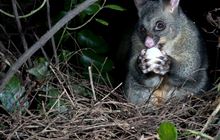Possums
Introduction
The possum is one of the greatest threats to our natural environment.Description
The common brushtail possum, Trichosurus vulpecula, is endemic to Australia and was first introduced to New Zealand from Australia in 1837 to establish a fur trade. This release was unsuccessful and a second release in 1858 at the same Southland location was required for them to establish.
The brushtail possum may be mis-named as an opossum, Didelphis sp., which is an American animal not present in New Zealand.
The possum has a thick, bushy tail, thick body fur, a pointed snout and large, pointed ears. There are two colour forms of the species - grey and black, with many variations in appearance. Possums can walk, jump and bound and its prehensile tail helps it move around tree branches.
The size and weight of possums varies across New Zealand. Typically, adult possums are 65 to 95 cm long and weigh 1.4 to 6.4 kg.
Possums are nocturnal and can live anywhere where there is shelter and a varied food supply. They are now widespread across most of New Zealand. The main habitat is forest, and possum densities can be particularly high in podocarp-broadleaf forests. Margins where forest meets pasture are also popular habitat and support very dense populations.
The threat
Possums have a significant impact on many of New Zealand’s natural ecosystems. They occur in high numbers and their own predators, such as feral cats, do not have much effect on controlling possum population size.
Leaves are the main part of their diet, but possums are opportunistic omnivores, and eat native birds and their eggs, land snails such as Powelliphanta and as invertebrates including weta. They eat buds, flowers, fruit/berries and nectar, which means they compete with native birds and reptiles for food sources. The growth and life-cycle of a tree or plant is significantly affected when all parts of it are eaten. Possums also have ‘favourites’ such as rātā or kamahi trees, leading to an even greater impact on these species.
Possums often occupy holes in tree trunks for their nests which would otherwise be used by nesting birds such as kākāriki and saddlebacks.
Dairy and deer farmers have the added worry of possums spreading bovine tuberculosis. The value of economic loss in primary production for damage and control of possums is in the tens of millions.
Evidence shows stoats and possums are eating kea. Researchers using nest-cameras have witnessed the gruesome reality inside defenceless kea nests invaded by stoats and possums in South Westland.
You can help to control possums
Regular predator control will help to control possum numbers and get us closer to the Predator Free 2050 goal.
DOC's work
DOC is charged with the care of New Zealand's native plants and wildlife. The survival of whole ecosystems is affected by the possum.
We are one of the many agencies that manage possum control - other agencies include OSPRI, regional councils and the Ministry for Primary Industries.
DOC commits resources to possum control at priority sites to ensure long-term survival of species and the ecosystems that support them.

